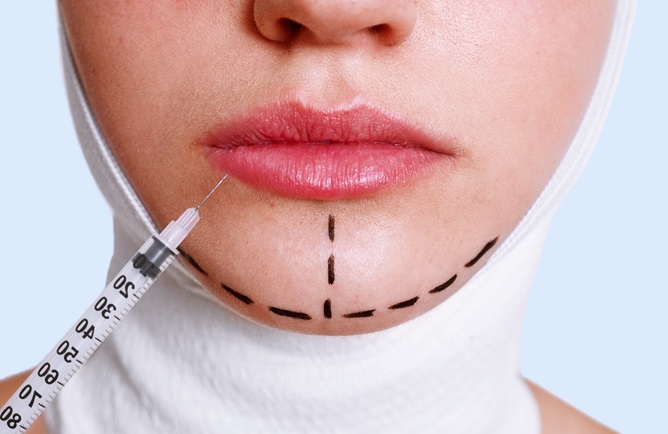Jawline surgery can improve the definition and balance of your facial features. Learn about the benefits, risks, and recovery process of this procedure, and find a qualified surgeon near you. Increase your self-confidence with a more sculpted and defined jawline.
Chin liposuction is an important aspect of Jawline Surgery as fat accumulation in the chin area is often a major contributor to the lack of definition in the jawline. Chin liposuction is a minimally invasive procedure that can effectively remove excess fat under the chin and improve the contour of the jawline.
The procedure involves making a small incision under the chin and using a cannula to suction out the excess fat. This not only helps to create a more defined jawline but can also help to reduce the appearance of a double chin. Chin liposuction is often performed in conjunction with other jawline surgery procedures such as chin implants or jawline contouring to achieve the desired aesthetic outcome.
Table of Contents
What is Jawline Surgery?
Jawline surgery, also known as mandibular contouring, is a cosmetic procedure that aims to enhance the appearance of the jawline by modifying its shape and size. This surgical procedure involves reshaping the lower jawbone to achieve a more defined and proportionate jawline.
Benefits of Jawline Surgery
Jawline surgery, also known as orthognathic surgery, can offer many benefits for individuals looking to improve the definition and balance of their facial features. This procedure can help to correct a range of concerns, such as a weak or receding chin, an asymmetrical jawline, or excess fat or skin under the chin.
By improving the harmony of the facial structure, jawline surgery can enhance your overall appearance and increase your self-confidence. It can also help with functional issues like difficulty chewing or speaking, breathing problems, or temporomandibular joint (TMJ) disorders.
With advances in surgical techniques and technology, jawline surgery is now safer and more effective than ever. Recovery times can vary depending on the extent of the surgery, but many patients are able to return to work and normal activities within a few weeks.
If you are considering jawline surgery, it’s important to consult with a qualified and experienced surgeon who can assess your individual needs and help you achieve the best possible results. With the right care and guidance, jawline surgery can be a life-changing investment in your self-image and well-being.
Jawline surgery can provide numerous benefits, including:
- Improved facial symmetry
- Enhanced definition of the jawline
- More youthful appearance
- Boost in self-confidence and self-esteem
- Better fit for dental and orthodontic appliances

Candidates for Jawline Surgery
- Have a weak or undefined jawline
- Suffer from an overbite or underbite
- Have a small or recessed lower jaw
- Are in good overall health
- Have realistic expectations about the outcome of the procedure
Types of Jawline Surgery
- Mandibular angle reduction: This surgery involves reducing the size of the jawbone to create a more defined angle between the jaw and the neck.
- Genioplasty: This surgery modifies the chin’s size and shape to create a more balanced and proportionate jawline.
- Jawline augmentation: This procedure uses implants to add volume to the jawline, creating a more defined and prominent appearance.
- Orthognathic surgery: This surgery corrects the alignment of the upper and lower jawbones to improve the bite and facial appearance.
Risks and Complications
Like any surgical procedure, jawline surgery comes with some risks and potential complications. Some of the most common risks associated with jawline surgery include bleeding, infection, anesthesia complications, and damage to nerves or other structures in the face.
Other potential complications may include prolonged swelling or bruising, delayed healing, or changes in sensation or movement in the face. In rare cases, patients may experience more serious complications such as blood clots, pulmonary embolism, or stroke.
It’s important to understand that every patient is unique, and the risks and potential complications of jawline surgery will vary depending on factors such as age, health status, and the extent of the procedure. Your surgeon will carefully evaluate your individual case and provide you with detailed information about the risks and benefits of jawline surgery, as well as any alternatives or complementary treatments that may be available.
By carefully following your surgeon’s instructions before and after surgery, you can minimize your risk of complications and achieve the best possible outcome from your procedure. Be sure to ask your surgeon any questions or concerns you may have about the risks and benefits of jawline surgery, and work together to develop a personalized treatment plan that meets your needs and goals.
Like any surgical procedure, jawline surgery carries some risks and potential complications, such as:
- Swelling and bruising
- Numbness or tingling
- Infection
- Bleeding
- Scarring
- Unsatisfactory results

Preparing for Jawline Surgery
Before undergoing jawline surgery, your surgeon will provide you with specific instructions to follow, such as:
- Avoiding smoking and drinking alcohol for several weeks before and after the procedure
- Discontinuing certain medications or supplements that may increase the risk of bleeding
- Arranging for someone to drive you home after the procedure
- Fasting for a certain period before the surgery
Procedure of Jawline Surgery
The procedure for jawline surgery varies depending on the type of surgery chosen. In general, the surgeon will make incisions inside the mouth to access the jawbone and perform the necessary modifications. In some cases, an incision may be made under the chin or along the jawline. The procedure typically takes a few hours to complete.
Recovery after Jawline Surgery
After the surgery, you will experience some discomfort, swelling, and bruising around the jawline, which can last for several weeks. Your surgeon may recommend pain medication, antibiotics, and a special diet to follow during the recovery period. You will also need to avoid strenuous activities and follow a specific aftercare plan to ensure proper healing.
Results
The results of jawline surgery are typically visible immediately after the procedure, although the final results may take several months to appear another benefit of jawline surgery is that it can address a variety of concerns.
For example, some people may have a receding chin or an asymmetrical jawline. Jawline surgery can help to correct these issues and improve facial harmony. Additionally, some individuals may have excess fat or skin under their chin, which can create the appearance of a double chin. In these cases, a combination of jawline surgery and chin liposuction may be recommended.
If you are considering jawline surgery, it is important to do your research and find a qualified and experienced surgeon. During your consultation, your surgeon will evaluate your facial structure and discuss your goals to determine the best approach for your needs. While jawline surgery can be a significant investment, the results can be life-changing and boost your self-confidence.

